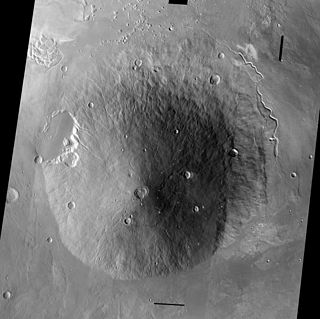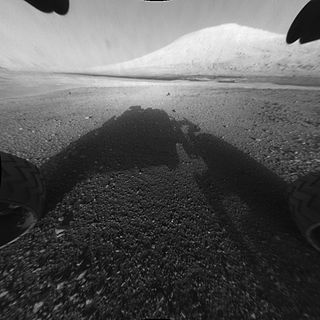Related Research Articles

The search for extraterrestrial intelligence (SETI) is a collective term for scientific searches for intelligent extraterrestrial life, for example, monitoring electromagnetic radiation for signs of transmissions from civilizations on other planets.

A Martian meteorite is a rock that formed on Mars, was ejected from the planet by an impact event, and traversed interplanetary space before landing on Earth as a meteorite. As of September 2020, 277 meteorites had been classified as Martian, less than half a percent of the 72,000 meteorites that have been classified. The largest complete, uncut Martian meteorite, Taoudenni 002, was recovered in Mali in early 2021. It weighs 14.5 kilograms and is on display at the Maine Mineral & Gem Museum.

The Lunar Orbiter program was a series of five uncrewed lunar orbiter missions launched by the United States from 1966 through 1967. Intended to help select Apollo landing sites by mapping the Moon's surface, they provided the first photographs from lunar orbit and photographed both the Moon and Earth.

The Mars Reconnaissance Orbiter (MRO) is a spacecraft designed to search for the existence of water on Mars and provide support for missions to Mars, as part of NASA's Mars Exploration Program. It was launched from Cape Canaveral on August 12, 2005, at 11:43 UTC and reached Mars on March 10, 2006, at 21:24 UTC. In November 2006, after six months of aerobraking, it entered its final science orbit and began its primary science phase.

Phoenix was an uncrewed space probe that landed on the surface of Mars on May 25, 2008, and operated until November 2, 2008. Phoenix was operational on Mars for 157 sols. Its instruments were used to assess the local habitability and to research the history of water on Mars. The mission was part of the Mars Scout Program; its total cost was $420 million, including the cost of launch.

Jill Cornell Tarter is an American astronomer best known for her work on the search for extraterrestrial intelligence (SETI). Tarter is the former director of the Center for SETI Research, holding the Bernard M. Oliver Chair for SETI at the SETI Institute. In 2002, Discover magazine recognized her as one of the 50 most important women in science.

The SETI Institute is a not-for-profit research organization incorporated in 1984 whose mission is to explore, understand, and explain the origin and nature of life in the universe, and to use this knowledge to inspire and guide present and future generations, sharing knowledge with the public, the press, and the government. SETI stands for the "search for extraterrestrial intelligence".

Project Ozma was a search for extraterrestrial intelligence (SETI) experiment started in 1960 by Cornell University astronomer Frank Drake, at the National Radio Astronomy Observatory, Green Bank at Green Bank, West Virginia. The object of the experiment was to search for signs of life in distant planetary systems through interstellar radio waves. The program was named after Princess Ozma, ruler of the fictional land of Oz, inspired by L. Frank Baum's supposed communication with Oz by radio to learn of the events in the books taking place after The Emerald City of Oz. The search was publicized in articles in the popular media of the time, such as Time magazine and was described as the first modern SETI experiment.

Richard Hudson Bryan is a retired American politician and attorney who served as the 25th Governor of Nevada from 1983 to 1989 and as a United States Senator representing Nevada from 1989 until 2001. A Democrat, Bryan previously served as the state's attorney general and a member of the State Senate.

Delta Pavonis, Latinized from δ Pavonis, is a single star in the southern constellation of Pavo. It has an apparent visual magnitude of 3.56, making it a fourth-magnitude star that is visible to the naked eye from the southern hemisphere. Parallax measurements yield an estimated distance of 19.89 light-years from Earth. This makes it one of the nearest bright stars to the Solar System. It is approaching the Sun with a radial velocity of −23.5 km/s, and is predicted to come as close as 17.8 light-years in around 49,200 years.
Kent Cullers was an American astronomer, who was a manager of SETI's Project Phoenix. In 2005, he retired from the SETI Institute.

Hecates Tholus is a Martian volcano, notable for results from the European Space Agency's Mars Express mission which indicate a major eruption took place 350 million years ago. The eruption created a caldera 10 km in diameter on the volcano's western flank.
Project Cyclops is a 1971 NASA project that investigated how SETI should be conducted. As a NASA product the report is in the public domain. The project team created a design for coordinating large numbers of radio telescopes to search for Earth-like radio signals at a distance of up to 1,000 light-years to find intelligent life. The proposed design involving between 1,000 and 2,500 steerable dishes of 100m diameter each was shelved due to costs. However, the report became the basis for much of the SETI work to follow.

Cydonia is a region on the planet Mars that has attracted both scientific and popular interest. The name originally referred to the albedo feature that was visible from earthbound telescopes. The area borders the plains of Acidalia Planitia and the highlands of Arabia Terra. The region includes the named features Cydonia Mensae, an area of flat-topped mesa-like features; Cydonia Colles, a region of small hills or knobs; and Cydonia Labyrinthus, a complex of intersecting valleys. As with other albedo features on Mars, the name Cydonia was drawn from classical antiquity, in this case from Kydonia, a historic polis on the island of Crete. Cydonia contains the "Face on Mars", located about halfway between the craters Arandas and Bamberg.

Mars is the fourth planet and the furthest terrestrial planet from the Sun. The reddish color of its surface is due to finely grained iron(III) oxide dust in the soil, giving it the nickname "the Red Planet". Mars's radius is second smallest among the planets in the Solar System at 3,389.5 km (2,106 mi). The Martian dichotomy is visible on the surface: on average, the terrain on Mars's northern hemisphere is flatter and lower than its southern hemisphere. Mars has a thin atmosphere made primarily of carbon dioxide and two irregularly shaped natural satellites: Phobos and Deimos.

Mount Sharp, officially Aeolis Mons, is a mountain on Mars. It forms the central peak within Gale crater and is located around 5.08°S 137.85°E, rising 5.5 km (18,000 ft) high from the valley floor. Its ID in the United States Geological Survey's Gazetteer of Planetary Nomenclature is 15000.

Curiosity is a car-sized Mars rover exploring Gale crater and Mount Sharp on Mars as part of NASA's Mars Science Laboratory (MSL) mission. Curiosity was launched from Cape Canaveral (CCAFS) on November 26, 2011, at 15:02:00 UTC and landed on Aeolis Palus inside Gale crater on Mars on August 6, 2012, 05:17:57 UTC. The Bradbury Landing site was less than 2.4 km (1.5 mi) from the center of the rover's touchdown target after a 560 million km (350 million mi) journey.

Kepler-62e is a super-Earth exoplanet discovered orbiting within the habitable zone of Kepler-62, the second outermost of five such planets discovered by NASA's Kepler spacecraft. Kepler-62e is located about 990 light-years from Earth in the constellation of Lyra. The exoplanet was found using the transit method, in which the dimming effect that a planet causes as it crosses in front of its star is measured. Kepler-62e may be a terrestrial or ocean-covered planet; it lies in the inner part of its host star's habitable zone.

Technosignature or technomarker is any measurable property or effect that provides scientific evidence of past or present technology. Technosignatures are analogous to biosignatures, which signal the presence of life, whether intelligent or not. Some authors prefer to exclude radio transmissions from the definition, but such restrictive usage is not widespread. Jill Tarter has proposed that the search for extraterrestrial intelligence (SETI) be renamed "the search for technosignatures". Various types of technosignatures, such as radiation leakage from megascale astroengineering installations such as Dyson spheres, the light from an extraterrestrial ecumenopolis, or Shkadov thrusters with the power to alter the orbits of stars around the Galactic Center, may be detectable with hypertelescopes. Some examples of technosignatures are described in Paul Davies's 2010 book The Eerie Silence, although the terms "technosignature" and "technomarker" do not appear in the book.

Phobos And Deimos & Mars Environment (PADME) is a low-cost NASA Mars orbiter mission concept that would address longstanding unknowns about Mars' two moons Phobos and Deimos and their environment.
References
- ↑ Tarter, J. C.; Gulkis, S. (1 May 1993). "The NASA High Resolution Microwave Survey". American Astronomical Society Meeting Abstracts #182. 182: 71.01. Bibcode:1993AAS...182.7101T . Retrieved July 4, 2023.
- 1 2 3 Davis, Jason (25 October 2017). "Is there anybody out there?". The Planetary Society.
- ↑ Alexander, Amir. "A History of SETI - Explore the Cosmos". The Planetary Society . Archived from the original on September 9, 2009. Retrieved February 4, 2010.
But less than one year after their launch, both searches were suddenly and irrevocably terminated, victims of a new wave of Congressional budget cuts. This time it was Senator Richard Bryan of Nevada who led the charge against governmental expenditures on SETI. "The Great Martian Chase," he said, "may finally come to an end. As of today millions have been spent and we have yet to bag a single little green fellow. Not a single Martian has said take me to your leader, and not a single flying saucer has applied for FAA approval."
- Morrison, Philip (1995). Nothing is Too Wonderful to be True. Volume 11 of Masters of Modern Physics. Springer. ISBN 1-56396-363-9.